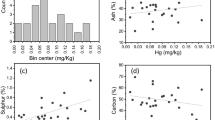Abstract
In India, coal utilization in power generation, constitutes as the single largest source of mercury emissions. This study presents mercury content in Indian sub-bituminous and bituminous coals that are primarily used as fuel in large-scale electricity generation facilities. A total of 165 number of coal samples have been collected from the major coal producing regions of the country. Along with the mercury content, other chemical parameters like moisture, ash, volatile matter, total Sulphur and gross calorific value were also analyzed. Mercury concentrations of these coals were found to be between 3 and 554 µg/kg, with an average of 175 µg/kg. Variation of the mercury content with the rank parameters like volatile matter, carbon content, ash and total Sulphur were also assessed. No significant correlations were observed with the rank parameters but a general trend of increasing mercury with ash content is discernible.











Similar content being viewed by others
References
BHEL (2004) Assessment and development of environmental standards of heavy metals and trace elements emissions from coal based thermal power plant. BHEL, New Delhi
BP (2019) Statistical review of World energy. BP, London
Burmistrz P, Kogut K, Marczak M, Zwoździak J (2016) Lignites and subbituminous coals combustion in Polish power plants as a source of anthropogenic mercury emission. Fuel Process Technol 152:250–258
Burmistrz P, Kogut K, Marczak M, Dziok T, Górecki J (2018) Mercury in polish coking bituminous coals. Energy Fuels 32(5):5677–5683
CPCB (2001) Mercury balance in thermal power plants, CPCB Annual Report, 2001. CPCB, New Delhi
CSE (Center for Science and Environment) (2005) The mercurial menace, vol 3. CSE, Delhi, pp 1–11
Chou C-L (2012) Sulfur in coals: a review of geochemistry and origins. Int J Coal Geol 100:1–13
Das TB, Pal SK, Gouricharan T, Sharma KK, Choudhury A (2013) Evaluation of reduction potential of selected heavy metals from an indian coal by conventional coal cleaning. Int J Coal Prep Util 33:300–312
Energy statistics (2019) Ministry of Statistics and Programme Implementation Government of India
GSI (2017) Geological Survey of India Report on ‘Inventory of coal resources of India-2017. GSI, Kolkata
Ghosh SB, Das MC, Roy RR, Banerjee NN (1994) Mercury in Indian coal. Indian J Chem Technol 1:237
Mishra HK, Chandra TK, Verma RP (1990) Petrology of some Permian coals of India. Indian J Coal Geol 16:47–71
Mukherjee AB, Bhattacharya P (2009) Mercury emissions from industrial sources in India and its effects in the environment, vol 4. Springer, Cham, pp 81–112
Mukherjee KN, Dutta NR, Chandra D, Pandalai HS, Singh MP (1988) Statistical approach to the study of the distribution of trace elements and their organic inorganic affinity in Lower Gondawana coals of India. Int J Coal Geol 10(1):99–108
Mukherjee AB, Zevenhoven R, Bhattachrya P, Sajwan KS, Kikuchi R (2008) Mercuryflow via coal and coal utilization by-products: a global perspective. Res Conserv Recycl 52:571–591
Mukhopadhyay G, Mukhopadhyay SK, Roychowdhury M, Parui PK (2010) Stratigraphic correlation between different Gondwana Basins of India. J Geol Soc India 76:251–266
Saini MK, Srivastava PK (2017) Effect of coal cleaning on ash composition and its fusion characteristics for a high-ash non-coking coal of India. Int J Coal prep Util 37(1):1–11
Selin NE (2009) Global biogeochemical cycling of mercury: a review. Annu Rev Environ Res 38:43–63
Sen K, Das NS, Choudhury A, Choudhury N, Mitra SK, Chakrabory DK, Dutta RK, Mitra A (2003) Quality reassessment and evaluation of utilisation potential for Indian Coals of Gondwana formation. J Mines, Metals & Fuels 51:5–14
Sundseth K, Pacyna JM, Pacyna EG, Munthe J, Belhaj M, Astrom SJ (2010) Economic benefits from decreased mercury emissions: projections for 2020. J Cleaner Prod 18:386–394
UNEP (2013) Global mercury assessments 2013; sources, emissions, releases and transport. Report of United Nations Environmental Programme, Chemicals. UNEP, Nairobi
UNEP (2014) Characterization of the coal fired power sector in India, assessment of the mercury contents in coal fed to power plants and calculation of mercury emissions from the sector’ UNEP Chemicals Branch. https://www.unep.org/hazardoussubstances/Mercury/PrioritiesforAction/Coalcombustion/Reports/tabid/4492/language/en-US/Default.aspx
Veevers JJ, Tewari RC (1995) Gondwana master basin of Peninsular India between Tethys and the interior of the Gondwanaland Province of Pangea, vol 187. Memoir Geological Society of America, Boulder, pp 1–73
Wichlinski M, Kobylecki R, Bis Z (2013) An investigation of mercury contents of Polish coal samples. Arch Environ Prot 39(2):141
Acknowledgments
The authors acknowledge the coal companies like subsidiaries of Coal India Limited and Singerani Collieries Company Limited for allowing collecting representative coal samples from their mines. Authors are also thankful to the Power Companies for arranging for collection of coal samples. Authors thankfully acknowledge Director, CSIR-Central Institute of Mining and Fuel Research, Dhanbad for funding the study and providing constant encouragement and support.
Author information
Authors and Affiliations
Corresponding authors
Ethics declarations
Conflict of interest
Authors declare no competing financial interest.
Additional information
Publisher's Note
Springer Nature remains neutral with regard to jurisdictional claims in published maps and institutional affiliations.
Rights and permissions
About this article
Cite this article
Das, T.B., Senapati, R.N. & Agarwalla, H. Mercury in Indian Thermal Coals. Bull Environ Contam Toxicol 105, 502–512 (2020). https://doi.org/10.1007/s00128-020-02945-3
Received:
Accepted:
Published:
Issue Date:
DOI: https://doi.org/10.1007/s00128-020-02945-3




